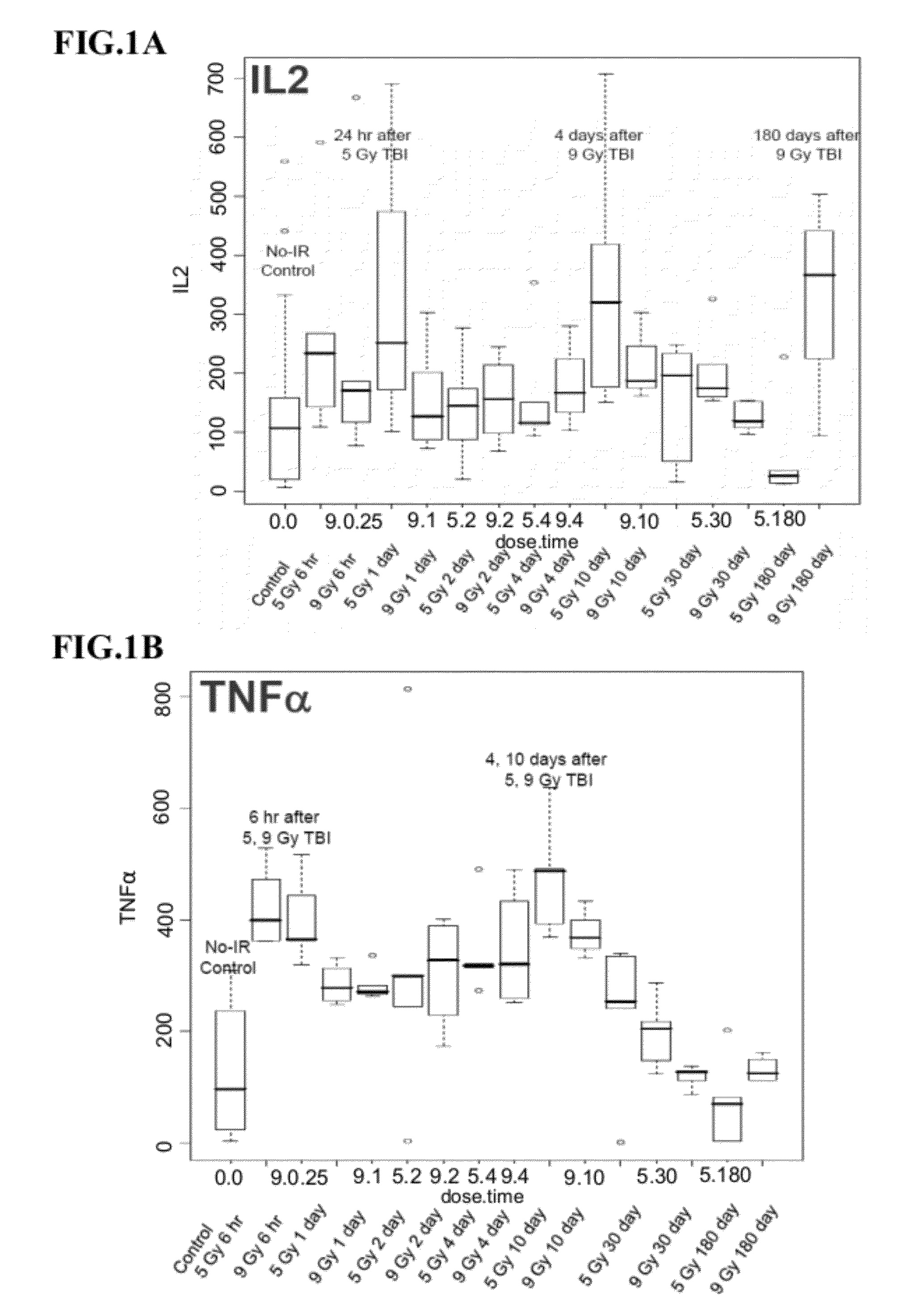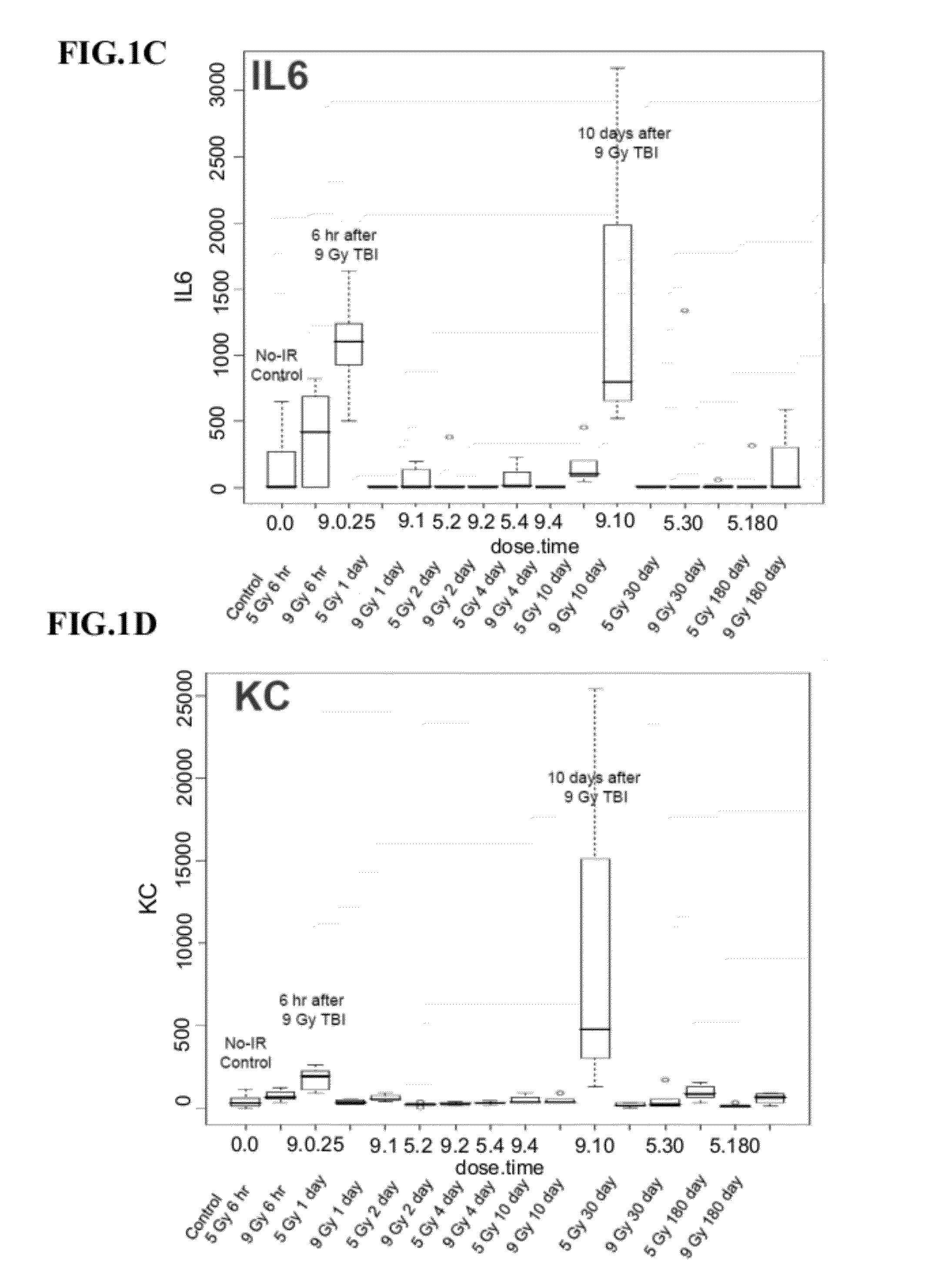Use of glycyrrhetinic acid, glycyrrhizic acid and related compounds for prevention and/or treatment of pulmonary fibrosis
- Summary
- Abstract
- Description
- Claims
- Application Information
AI Technical Summary
Benefits of technology
Problems solved by technology
Method used
Image
Examples
example 1
Induction of Inflammatory Responses by IR
[0112]Briefly, C57BL / 6 fibrosis-prone mice were exposed to IR at 0, 5, or 9 Gy. As shown in FIG. 1, IR induces a first surge in inflammatory responses 6 hours after exposure, a second surge 4-10 days after exposure, and a third surge 180 days aftr exposure (IL2 only) (FIG. 1, first lane: normal control). FIG. 2 shows surges of IM levels in C57BL / 6 and C3H / NeH mice with IR-induced traumatic brain injury (TBI) 6 hr, 1, 2, 4, and 10 days after exposure at 9 Gy. This indicates that IR induces inflammatory responses and the levels of inflammatory mediators can be used to monitor IR-induced lung injury.
example 2
Modulation of Inflammatory Responses During the Acute Phase of IR-Induced Pneumonitis
[0113]This Example demonstrates that GA suppresses the surge in inflammatory responses during the acute phase of IR-induced pneumonitis, which occurs within 48 hours after IR exposure to mice. Briefly, C57BL / 6 fibrosis-prone mice received a single-dose of thoracic IR at 15 Gy with a dose rate of 1.9 Gy / min. Six hours after IR exposure, the mice were divided into the following treatment groups: 1) normal (received 0 Gy; no treatment); 2) vehicle-treated; 3) GA-treated (30-40 mg / kg / q.o.d) (i.e. every other day) (the GA dosage used herein was derived from the effective dosage for humans (3-4 mg / kg), which is typically 6-10 times lower than that of mice); 4) dexamethasone-treated (Positive Control 1) (Dex, 3 mg / kg, i.m. or p.o. qod); 5) amifostine-treated (Positive Control 2) (Ami, 200 mg / kg / i.v, 0.5 hr prior to irradiation); and 6) celebrex-treated (Positive Control 3) (30 mg / kg, po, qod).
[0114]The mi...
example 3
Suppression of Plasma Exudation and Inflammatory Cell Infiltration During the Acute Phase of IR-Induced Pneumonitis
[0116]This Example demonstrates that GA suppresses IR-induced plasma exudation and inflammatory cell infiltration during the acute phase of IR-induced pneumonitis. Briefly, C57BL / 6 fibrosis-prone mice received a single-dose of thoracic IR at 15 Gy with a dose rate of 1.9 Gy / min and were treated as described in Example 2. The mice were sacrificed 2.5 days after IR exposure, and lung tissues were harvested and analyzed for morphological changes.
[0117]As shown in FIG. 4, the vehicle-treated lungs were filled with infiltrated inflammatory cells and plasma exudates, as compared to non-IR-exposed normal lungs. GA potently suppressed plasma exudation and inflammatory cell infiltration into the interstitial space. Celebrex, dexamethasone and amifostine also produced similar treatment effects.
PUM
| Property | Measurement | Unit |
|---|---|---|
| Time | aaaaa | aaaaa |
| Time | aaaaa | aaaaa |
| Solar gamma radiation | aaaaa | aaaaa |
Abstract
Description
Claims
Application Information
 Login to View More
Login to View More - R&D
- Intellectual Property
- Life Sciences
- Materials
- Tech Scout
- Unparalleled Data Quality
- Higher Quality Content
- 60% Fewer Hallucinations
Browse by: Latest US Patents, China's latest patents, Technical Efficacy Thesaurus, Application Domain, Technology Topic, Popular Technical Reports.
© 2025 PatSnap. All rights reserved.Legal|Privacy policy|Modern Slavery Act Transparency Statement|Sitemap|About US| Contact US: help@patsnap.com



